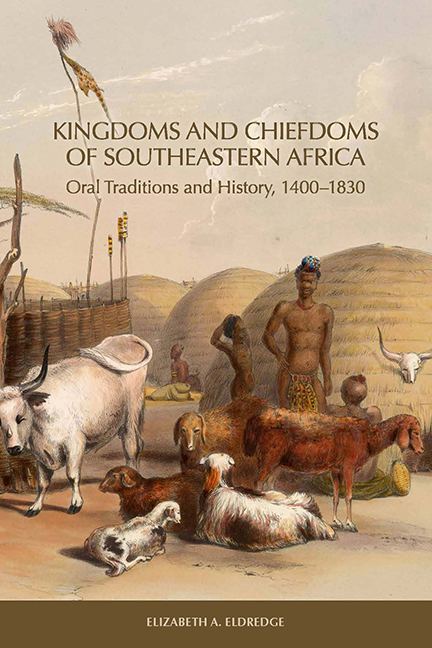Book contents
- Frontmatter
- Contents
- List of Illustrations
- Preface
- 1 History and Oral Traditions in Southeastern Africa
- 2 Oral Traditions in the Reconstruction of Southern African History
- 3 Shipwreck Survivor Accounts from the Sixteenth and Seventeenth Centuries
- 4 Founding Families and Chiefdoms East of the Drakensberg
- 5 Maputo Bay Peoples and Chiefdoms before 1740
- 6 Maputo Bay, 1740–1820
- 7 Eastern Chiefdoms of Southern Africa, 1740–1815
- 8 Zulu Conquests and the Consolidation of Power, 1815–21
- 9 Military Campaigns, Migrations, and Political Reconfiguration
- 10 Ancestors, Descent Lines, and Chiefdoms West of the Drakensberg before 1820
- 11 The Caledon River Valley and the BaSotho of Moshoeshoe, 1821–33
- 12 The Expansion of the European Presence at Maputo Bay, 1821–33
- 13 Southern African Kingdoms on the Eve of Colonization
- Appendix A Ama Swazi King Lists
- Appendix B Chronology of Conflicts, Migrations, and Political Reconfiguration East of the Drakensberg in the Era of Shaka
- Appendix C Interviewees from the James Stuart Collection of Oral Traditions
- Notes
- Bibliography
- Index
13 - Southern African Kingdoms on the Eve of Colonization
Published online by Cambridge University Press: 14 March 2018
- Frontmatter
- Contents
- List of Illustrations
- Preface
- 1 History and Oral Traditions in Southeastern Africa
- 2 Oral Traditions in the Reconstruction of Southern African History
- 3 Shipwreck Survivor Accounts from the Sixteenth and Seventeenth Centuries
- 4 Founding Families and Chiefdoms East of the Drakensberg
- 5 Maputo Bay Peoples and Chiefdoms before 1740
- 6 Maputo Bay, 1740–1820
- 7 Eastern Chiefdoms of Southern Africa, 1740–1815
- 8 Zulu Conquests and the Consolidation of Power, 1815–21
- 9 Military Campaigns, Migrations, and Political Reconfiguration
- 10 Ancestors, Descent Lines, and Chiefdoms West of the Drakensberg before 1820
- 11 The Caledon River Valley and the BaSotho of Moshoeshoe, 1821–33
- 12 The Expansion of the European Presence at Maputo Bay, 1821–33
- 13 Southern African Kingdoms on the Eve of Colonization
- Appendix A Ama Swazi King Lists
- Appendix B Chronology of Conflicts, Migrations, and Political Reconfiguration East of the Drakensberg in the Era of Shaka
- Appendix C Interviewees from the James Stuart Collection of Oral Traditions
- Notes
- Bibliography
- Index
Summary
The advent of European traders and missionaries into the interior of southern Africa and along the southeastern coast after 1800 challenged the independence and autonomy of African chiefs and kingdoms. The interaction between Africans and Europeans brought new infLuences and new perspectives on events as they occurred and were witnessed and recorded by Europeans. Later generations remembered stories from their histories that had been orally transmitted, along with the genealogies of their ancestors, but by the end of the nineteenth century the written word would overcome the use of oral transmission as the record of history and historians. Among the last significant oral traditions of the newly emergent Ama- Zulu kingdom was that of the death of Shaka, who was both respected and reviled among the people who became the subjects of future Zulu kings.
The AmaZulu oral traditions have numerous stories about the latter years of Shaka's life and his assassination in September 1828. Shaka had developed a contentious relationship with the Europeans traders who had established themselves at Port Natal (Durban) in 1824, had heard rumors of the strength of the AmaXhosa chiefs of the TransKei and CisKei, and nurtured ambitions for expansion in the direction of the Cape Colony. He opened negotiations with the Cape Colony through emissaries, led by a man named Sotobe, who went as far as Grahamstown but never made it all the way to Cape Town. Immediately after the death of his mother, Nandi, Shaka began building a new capital at Dukuza, near modern Stanger, and moved there from the ancient capital at Bulawayo. Makewu, in an 1899 interview, told Stuart,
Shaka built his principal Natal kraal where Stanger now stands and called it Dukuza. The reason for the name is that when he was at Gibixegu kraal [Bulawayo] in Zululand he was stabbed by Ntintinti ka Nkobe. The assegai, which he drew out, he recognized at belonging to Sipezi [the military barracks, or ikhanda, of the isiPhezi regiment] where his brothers lived (he had distributed to them this kind of assegai). It struck him high up the arm (right, I fancy) above the elbow and therefore penetrated the arm and just touched the side.
- Type
- Chapter
- Information
- Kingdoms and Chiefdoms of Southeastern AfricaOral Traditions and History, 1400–1830, pp. 313 - 326Publisher: Boydell & BrewerPrint publication year: 2015

